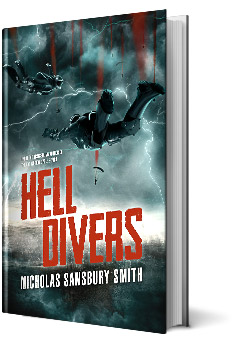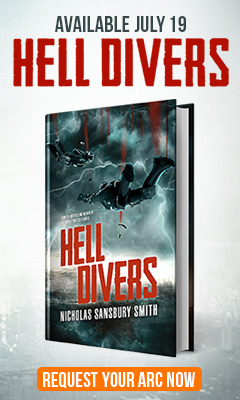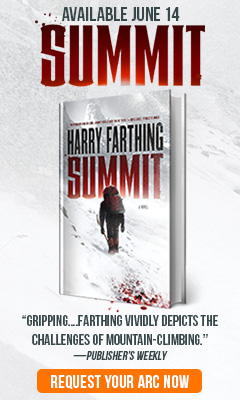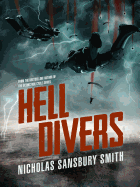Hell Divers
by Nicholas Sansbury Smith
More than two centuries after a catastrophic world war rendered the Earth uninhabitable, the scant remnants of humanity circle the skies in the same mammoth airships used to bomb civilization into oblivion. A fleet of ships once hundreds strong is now reduced to two: the Hive and the Ares, each carrying half of all remaining humans--scarcely over 1,000 souls total.
These ships have been in operation for hundreds of years beyond their originally intended lifespans. Their survival, and the survival of all mankind, depends on the service of a few dozen Hell Divers--brave men and women who jump thousands of feet to the planet's surface to collect the ancient components needed to keep the airships afloat. They must contend with fierce electrical storms, intense radiation and mutant monsters prowling crumbling city ruins. Their motto is simple: "We dive so humanity survives."
Xavier Rodriguez--better known as X--is by far the most accomplished Hell Diver on the Hive. The average diver survives 15 jumps; X has survived 95. Hell Divers opens with X preparing to make his 96th jump while nursing a hangover. It's been a year since he suffered a personal tragedy that, along with the high chance of death on every jump, has led him all too often to the bottom of a bottle of 'shine--a foul makeshift liquor. X has been prematurely aged by his nihilistic partying, the radiation he encounters outside the ship and the radiation permeating the Hive. But he is one of the lucky above-deckers, with his own cramped apartment, adequate rations and plenty of shielding between him and the Hive's nuclear generator. The unskilled lower-deckers cram into communal spaces in the ship's bowels, where cancer and deformities have worsened with every generation.
The lower-deckers are not the only victims of humanity's nuclear-fueled airborne existence. Captain Ash, commander of the Hive and former member of its security force, the Militia, is dying of throat cancer. Much to the dismay of her husband, Captain Ash has refused chemotherapy treatment so she can carry out her duties as long as possible. She vows what by now seems a vain hope--to find a safe place on the surface to land, where humanity can be earthbound once again.
But Captain Ash makes a terrible mistake, one that almost makes X's 96th dive his last: she sends X and his team into an electrical storm. Those team members not killed by lightning strikes on the dive fall victim to a new, even more horrifying threat--eyeless, pale humanoid mutants, wielding razor talons, tons of teeth and a hunger for human flesh. X is the mission's sole survivor. One of his comrades, a friend, has a son, who now falls into X's care. He is a pensive guardian, but the boy, called Tin for the foil hat he wears and his aptitude with electronics, may be just the right responsibility to make X stop drowning himself in 'shine.
Captain Ash gets little time to ruminate on her mistake. She receives a call for help from the Ares--the sister ship is above a wasteland called Hades, an Old World city targeted by so many bombs during the world-ending war that it became a frozen hellscape of radiation, blasting snow and constant electrical storms. Captain Ash can't imagine what desperation led the captain of the Ares to fly over that damned place, but she refuses to stand by and let half of the human race die. She steers the Hive toward Hades, to a dive that will push X and a team of rookie Hell Divers to their limits. Meanwhile, the discontent of the oppressed lower-deckers threatens to reignite a class struggle that led to deadly riots on the Hive just a few years prior.
In Hell Divers, Nicholas Sansbury Smith unleashes post-apocalyptic science-fiction with the pacing of a thriller. He achieves his world-building succinctly, and moves from thrills to chills without the story becoming a mere catalogue of violence, along with tender moments that round out the characters. Hell Divers offers genre fans everything they could ask for, from fresh takes on the post-apocalypse to social commentary reminiscent of Snowpiercer, and plenty of action. The book's swift, tight plotting will also appeal to thriller fans, with a cliffhanger ending that leaves readers suspended mid-air for the rest of a promised trilogy.
Nicholas Sansbury Smith is the author of the five-volume Extinction Cycle series, also post-apocalyptic thrillers, and the Orbs series, science-fiction thrillers about an alien invasion. Before turning to fiction writing, Smith worked for the Iowa Department of Homeland Security and Emergency Management in the field of disaster mitigation. Perhaps his career there is part of what makes Smith so good at imagining worst-case scenarios. Whatever his inspiration, Smith has crafted something enthralling with Hell Divers. --Tobias Mutter








